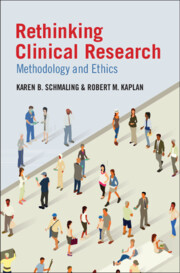Book contents
- Rethinking Clinical Research
- Rethinking Clinical Research
- Copyright page
- Contents
- Acknowledgments
- Introduction
- Part I Fundamentals
- Part II Rethinking Research
- Part III Case Studies
- 13 Case Study: Treating Gastroesophageal Reflux Disease with Omeprazole
- 14 Case Study: Statin Therapy for Primary Prevention of Heart Disease
- 15 Case Study: Cancer Screening
- 16 Case Study: Antidepressant Medications
- Conclusions and Recommendations
- Index
- References
Conclusions and Recommendations
from Part III - Case Studies
Published online by Cambridge University Press: 13 March 2025
- Rethinking Clinical Research
- Rethinking Clinical Research
- Copyright page
- Contents
- Acknowledgments
- Introduction
- Part I Fundamentals
- Part II Rethinking Research
- Part III Case Studies
- 13 Case Study: Treating Gastroesophageal Reflux Disease with Omeprazole
- 14 Case Study: Statin Therapy for Primary Prevention of Heart Disease
- 15 Case Study: Cancer Screening
- 16 Case Study: Antidepressant Medications
- Conclusions and Recommendations
- Index
- References
Summary
After reviewing a wide range of topics, we conclude that good science requires greater efforts to manage biases and to promote the ethical conduct of research. An important problem is the belief that randomized controlled trials (RCTs) are exempt from systematic bias. Throughout the book, we acknowledge the importance of RCTs, but also emphasize that they are not immune from systematic bias. A second lesson concerns conflict of interest, which must always be taken seriously. Most large RCTs are sponsored by for-profit pharmaceutical companies. We identify leverage points to address these problems. These include cultivating equipoise – the position that research investigators enter a study with the understanding that either a positive, negative, or null result is of value. We return to several other themes prominent throughout this book, including the reporting of research findings and serious problems with our system of peer review. The book concludes with recommendations for reducing conflicts of interest, improving transparency, and reimagining the peer review system.
Keywords
- Type
- Chapter
- Information
- Rethinking Clinical ResearchMethodology and Ethics, pp. 339 - 355Publisher: Cambridge University PressPrint publication year: 2025

